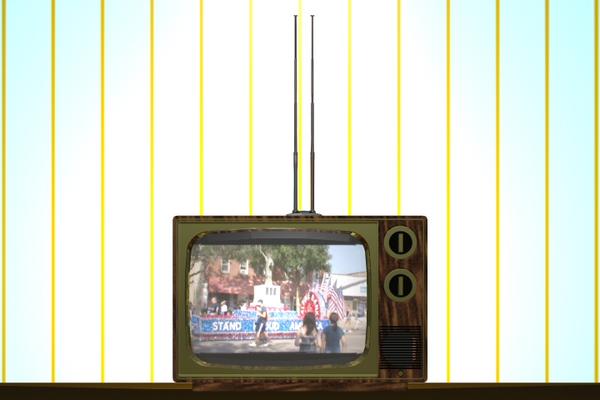Real video in Bryce animations
 CTippetts
Posts: 162
CTippetts
Posts: 162
Last night in a dream I received the idea to put real video into a Bryce animation, and, lo and behold, it seems to have actually worked. At the bottom of this post is a still image of the test of the principle. The Bryce rendered video that still image is from can be downloaded here:
https://www.dropbox.com/s/36jkdysmhpihtvj/2DAnimationTest2.avi?dl=0
Perhaps you know of this being done before, but I'm such a noob, I'm not aware of it. I only know of it being done as post-work to a Bryce rendered animation. This method is a real Bryce render for the final.
However, to do this I had to prepare using other software. I think that's a given, due to the fact that Bryce has no way to import video. Bryce can only render to video. As a test video I used a 2 second clip from some footage I shot in 2011 ... wanted something colorful with reds, blues, and greens. It was Ulead VideoStudio 10 I used to isolate the 2 second clip from the footage. I believe that product has been snatched up and buried by Corel, so version 10 is the last I would consider, if you can find it. However, there are many other video editing programs that can be used to make a 2 second clip from a longer video. VideoStudio also has the ability to save still images of video frames, but it's a bit cumbersome, so I didn't do that.
Speaking of Corel, Paint Shop Pro used to be owned by JASC, and version 9 is the last version they produced before Corel snatched up that product and broke it. I never got version 9. Version 8, which I did get, shipped with a bonus program called Animation Shop. It was mainly intended to make the kind of animated GIF images that used to populate most web sites before Flash caught on. Like DAZ Studio and Bryce, Animation Shop has a bridge to transfer frames to and from Paint Shop Pro without saving the file and then loading it. Um, that bridge works flawlessly. Yet, I digress, because the bridge was not needed for this test, but could have been used to introduce distortions, or even subliminals.
Animation Shop can load in video. It can also batch save all or a selection of the frames from the video as still images in various formats. I chose TIFF after loading in the 2 second clip, resizing the frames, and selecting all of the frames. This produced 59 TIFF files ... one for each frame of the video. (I guess I clipped it one frame short ... should have been 60.) Once again, I'm sure there is plenty of other software that can create the frames as individual files. As far as that goes, I could have even used Cyberlink Power DVD in a cumbersome fashion to take 2 seconds worth of frames from a movie DVD. I didn't. In fact, another good reason for me to use Animation Shop for this function is; you can resize the frames before export. In this test video linked to above, though the video is rendered at 720X480, the TIFF files only needed to be one fourth of that, which saves a bunch of Bryce memory. They probably could have been smaller.
Anyway, that was all of the preparation needed before switching to Bryce.
I set up a simple scene using this old TV I found on ShareCG and modified a bunch. One modification was to add a 2D Face behind the glass of the picture tube, and a Square Spotlight to light the 2D Face.
Then came the only cumbersome step to this process. I had to go into the Material Lab for each frame of the Bryce video and assign the new TIFF to the 2D Face for each frame, and make the key-frame entries for both the material, and the TIFF. Talk about room for error. However, it was only 30 frames, since it was just a test, and I chose 15FPS instead of 30FPS. I only loaded every other frame from the original video. (I cheated. Okay?) Possible errors when performing so many repetitions could include, accidentally hitting the X instead of the check mark on a frame, forgetting to make a key-frame, selecting the wrong TIFF file, and others, I'm sure. I don't think I made any of those mistakes ... this time.
While doing this I worried, "Uh, oh! There are only 30 slots here in the Material Lab palette for the pict based materials." That would mean 30 frames would be the limit for this method. However, what I found is; when you get to the 30th image, a scroll bar is created next to the image palette to allow more and more to be added ... until you run out of Bryce memory, I assume.
In this test I literally added real video to a Bryce rendered animation AS video. However, another application I can foresee for this method is to use an animated 2D Face for the sky and clouds. Perhaps you can think of and show us another application for this method. We're waiting.
HAVE FUN!




Comments
In the dev cycle we got video textures...so you can apply a video onto an object...